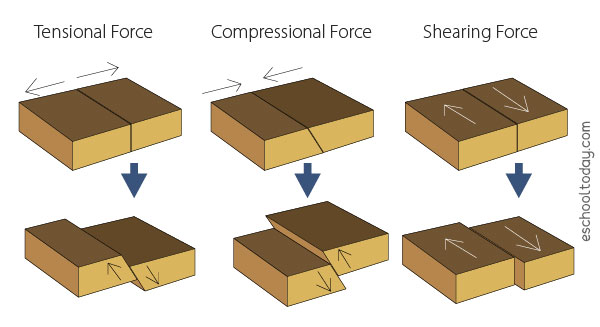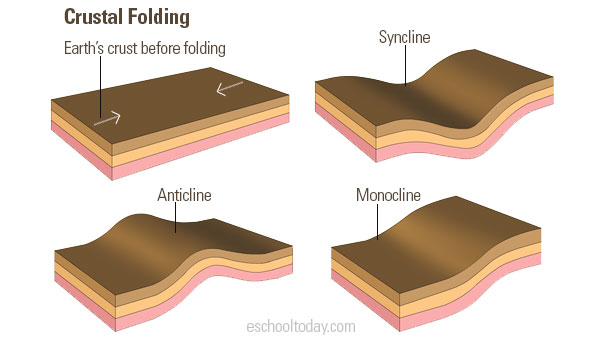- Landforms
Landforms formed from Crustal Deformation
Landforms can result from three main forces on plates in the earth’s crust.
- Compressional Forces: Plates are pushed together into each other.
- Tensional Forces: Plates are pulled apart from each other.
- Shearing: Plates slide past each other (not into each other).

These three forces cause crustal deformation, which is a constructive factor in the formation of landforms. When the earth’s crust or rock material on the earth’s surface deforms, it can be evident in its change in position, change in shape, or change in orientation.
The crust material may be Elastic, Brittle, or Ductile.
Elastic Crust
An elastic crust may stretch and fold under pressure but can return to its original position (like a rubber band).
Brittle Crust
It involves the part of the earth that is very hard and can break or shatter easily. Brittle deformation causes faults and joints when the earth’s crust changes temperatures, strain, or pressure. Both faults and folds are types of fractures.
- Joints
When there is cooling, weight, or tectonic stress, joints can occur in the earth’s crust. Note that there can be joints without sliding or moving apart. Joints can allow water, oil, and air into the crust.
- Faults
A fault is a fracture on which sliding of the earth’s crust has occurred. Some types of faults are Normal Fault, Reverse Fault, and Strike-Slip-Fault.
Ductile Crust
This means the part of the earth can be stretched or reshaped without breaking. Ductile crusts folds and foliations when compressional tectonic forces acting on the crust (just like the carpet folds when you push it together).

- Folds
Tectonic pressure in a ductile crust can cause folding. Folding can result in anticlines, synclines, and monoclines. They end up as valleys and mountains.
- Foliations
Foliations occur when pressure squeezes the minerals within the rock to cause them to align themselves. The sheet-like nature of the rock often reflects the direction of the pressure or squeeze.
